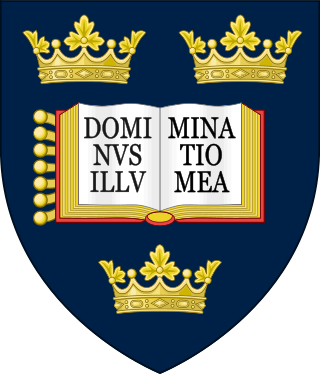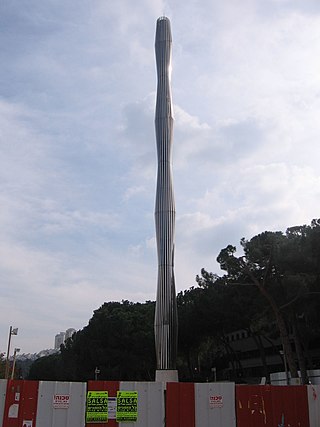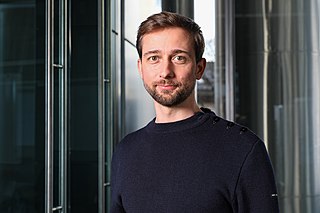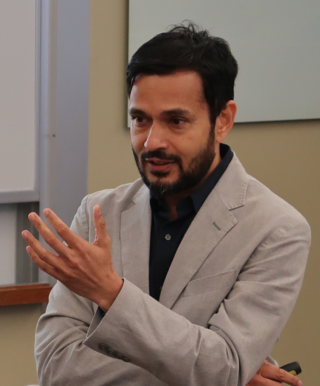Related Research Articles

A patent is a type of intellectual property that gives its owner the legal right to exclude others from making, using, or selling an invention for a limited period of time in exchange for publishing an enabling disclosure of the invention. In most countries, patent rights fall under private law and the patent holder must sue someone infringing the patent in order to enforce their rights.
Technology transfer (TT), also called transfer of technology (TOT), is the process of transferring (disseminating) technology from the person or organization that owns or holds it to another person or organization, in an attempt to transform inventions and scientific outcomes into new products and services that benefit society. Technology transfer is closely related to knowledge transfer.

A science park is defined as being a property-based development that accommodates and fosters the growth of tenant firms and that are affiliated with a university based on proximity, ownership, and/or governance. This is so that knowledge can be shared, innovation promoted, technology transferred, and research outcomes progressed to viable commercial products. Science parks are also often perceived as contributing to national economic development, stimulating the formation of new high-technology firms, attracting foreign investment and promoting exports.

The Bayh–Dole Act or Patent and Trademark Law Amendments Act is United States legislation permitting ownership by contractors of inventions arising from federal government-funded research. Sponsored by senators, Birch Bayh of Indiana and Bob Dole of Kansas, the Act was adopted in 1980, is codified at 94 Stat. 3015, and in 35 U.S.C. §§ 200–212, and is implemented by 37 C.F.R. 401 for federal funding agreements with contractors and 37 C.F.R 404 for licensing of inventions owned by the federal government.
A business incubator is an organization that helps startup companies and individual entrepreneurs to develop their businesses by providing a fullscale range of services, starting with management training and office space, and ending with venture capital financing. The National Business Incubation Association (NBIA) defines business incubators as a catalyst tool for either regional or national economic development. NBIA categorizes its members' incubators by the following five incubator types: academic institutions; non-profit development corporations; for-profit property development ventures; venture capital firms, and a combination of the above.
Patents are legal instruments intended to encourage innovation by providing a limited monopoly to the inventor in return for the disclosure of the invention. The underlying assumption is that innovation is encouraged because an inventor can secure exclusive rights and, therefore, a higher probability of financial rewards for their product in the marketplace or the opportunity to profit from licensing the rights to others. The publication of the invention is mandatory to get a patent. Keeping the same invention as a trade secret rather than disclosing it in a patent publication, for some inventions, could prove valuable well beyond the limited time of any patent term but at the risk of unpermitted disclosure or congenial invention by a third party.
Legal scholars, economists, activists, policymakers, industries, and trade organizations have held differing views on patents and engaged in contentious debates on the subject. Critical perspectives emerged in the nineteenth century that were especially based on the principles of free trade. Contemporary criticisms have echoed those arguments, claiming that patents block innovation and waste resources that could otherwise be used productively, and also block access to an increasingly important "commons" of enabling technologies, apply a "one size fits all" model to industries with differing needs, that is especially unproductive for industries other than chemicals and pharmaceuticals and especially unproductive for the software industry. Enforcement by patent trolls of poor quality patents has led to criticism of the patent office as well as the system itself. Patents on pharmaceuticals have also been a particular focus of criticism, as the high prices they enable puts life-saving drugs out of reach of many people. Alternatives to patents have been proposed, such as Joseph Stiglitz's suggestion of providing "prize money" as a substitute for the lost profits associated with abstaining from the monopoly given by a patent.

Oxford University Innovation Limited (OUI) is a British technology transfer and consultancy company created to manage the research and development (R&D) of university spin-offs. OUI is a wholly owned subsidiary of the University of Oxford, and is located on Botley Road, Oxford, England. OUI was previously known as Isis Innovation (1988–2016) and Oxford University Research and Development Ltd (1987–1988).
The NIH Office of Technology Transfer (OTT) plays a strategic role by supporting the patenting and licensing efforts of our NIH ICs. OTT protects, monitors, markets and manages the wide range of NIH discoveries, inventions, and other intellectual property as mandated by the Federal Technology Transfer Act and related legislation.
University spin-offs are companies that transform technological inventions developed from university research that are likely to remain unexploited otherwise. They are a subcategory of research spin-offs. Prominent examples of university spin-offs are Genentech, Crucell, Lycos and Plastic Logic. In most countries, universities can claim the intellectual property (IP) rights on technologies developed in their laboratories. In the United States, the Bayh–Dole Act permits universities to pursue ownership of inventions made by researchers at their institutions using funding from the federal government, where previously federal research funding contracts and grants obligated inventors to assign the resulting IP to the government. This IP typically draws on patents or, in exceptional cases, copyrights. Therefore, the process of establishing the spin-off as a new corporation involves transferring the IP to the new corporation or giving the latter a license on this IP. Most research universities now have Technology Licensing Offices (TLOs) to facilitate and pursue such opportunities.
Stanford University v. Roche Molecular Systems, Inc., 563 U.S. 776 (2011), was a United States Supreme Court case in which the Court held that title in a patented invention vests first in the inventor, even if the inventor is a researcher at a federally funded lab subject to the 1980 Bayh–Dole Act. The judges affirmed the common understanding of U.S. constitutional law that inventors originally own inventions they make, and contractual obligations to assign those rights to third parties are secondary.

T3 Technion Technology Transfer is the technology transfer unit of the Technion – Israel Institute of Technology in Israel. The unit operates under the auspices of the Technion Research & Development Foundation.
Canadian Patents and Development Limited (CPDL) was a Canadian agency tasked with promoting the commercialization of inventions and discoveries arising from government departments and agencies, as well as those disclosed to it by universities and others publicly funded organizations. The National Research Council of Canada (NRC) founded CPDL on October 24, 1947, as a subsidiary Crown Corporation under part 1 of the Canadian Companies Act (now Canadian Corporations Act). As a subsidiary of the NRC, CPDL was charged with handling the assessment, patenting, development, and licensing of the intellectual property developed by the scientific workers of the NRC. Soon after its incorporation, CPDL began making its services available to Canadian universities and other publicly financed organizations. The number of Canadian agencies and departments reporting inventions to CPDL increased substantially in 1954 with the enactment of the Public Servants' Inventions Act, which made CPDL eligible to accept and manage the inventions arising from all federal departments and agencies. Despite its broad mandate and many agreements, CPDL was noted by university administrators as possessing inadequate resources to effectively manage inventions for all of Canada's universities, while the industry consensus "was that CPDL's work was under-publicized, under-supported, undersold and under-followed-up." On February 20, 1990, the Minister of Finance announced the planned dissolution of CPDL as part of a larger government commitment to reducing the size of government and improving the efficiency of public services. A few months later, the Crown Corporation Dissolution or Transfer Authorization Bill (Bill C-73) was introduced to parliament to facilitate the closure of several crown corporations and the transfer of their responsibilities. The bill authorized the Minister of Industry, Science, and Technology to dissolve CPDL, and made government departments and agencies responsible for managing their own intellectual property. Following the Crown Corporation Dissolution or Transfer Authorization Bill, all CPDL agreements with Canadian universities were terminated, and all patented faculty inventions held by CPDL were transferred back to each respective university. On August 1, 1993 CPDL ceased all operations.
Patent analysis is the process of analyzing the texts of patent disclosures and other information from the patent lifecycle. Patent analysis is used to obtain deeper insights into different technologies and innovation. Other terms are sometimes used as synonyms for patent analytics: patent landscape, patent mapping, or cartography. However, there is no harmonized terminology in different languages, including in French and Spanish. Patent analytics encompasses the analysis of patent data, analysis of the scientific literature, data cleaning, text mining, machine learning, geographic mapping, and data visualisation.
Industry funding of academic research in the United States is one of the two major sources of research funding in academia along with government support. Currently, private funding of research accounts for the majority of all research and development funding in the United States as of 2007 overall. Overall, Federal and Industrial sources contribute similar amounts to research, while industry funds the vast majority of development work.
The triple helix model of innovation refers to a set of interactions between academia, industry and government, to foster economic and social development, as described in concepts such as the knowledge economy and knowledge society. In innovation helical framework theory, each sector is represented by a circle (helix), with overlapping showing interactions. The initial modelling has advanced from two dimensions to show more complex interactions, for example over time. The framework was first theorized by Henry Etzkowitz and Loet Leydesdorff in the 1990s, with the publication of "The Triple Helix, University-Industry-Government Relations: A laboratory for Knowledge-Based Economic Development". Interactions between universities, industries and governments have given rise to new intermediary institutions, such as technology transfer offices and science parks, and Etzkowitz and Ledersdorff theorized the relationship between the three sectors and explained the emergence of these new hybrid organizations. The triple helix innovation framework has been widely adopted and as applied by policy makers has participated in the transformation of each sector.
The common definition of academic entrepreneur is similar to the original definition of ‘entrepreneur.’ It states “the AE is a university scientist, most often a professor, sometimes a PhD student or a post-doc researcher, who sets up a business company in order to commercialize the results of his/her research” Academic entrepreneurship today can be understood as either:

Gaétan de Rassenfosse is a Belgian economist, whose research is specialized in the field of economics of innovation. He is a professor at EPFL, where he heads the Science, Technology and Innovation Policy Laboratory at the College of Management of Technology.

Ramot at Tel Aviv University LTD is Tel Aviv University's technology transfer company, owner of the intellectual property created by the university's researchers and responsible for the commercialization of such intellectual property. The company is considered a leader in its field.

Deepak Hegde is an Indian born American business scholar. He is the Seymour Milstein Professor of Strategy at the New York University, Stern School of Business.
References
- 1 2 3 Rothaermel, F. T.; Agung, S. D.; Jiang, L. (2007-08-01). "University entrepreneurship: a taxonomy of the literature". Industrial and Corporate Change. 16 (4): 691–791. doi:10.1093/icc/dtm023. ISSN 0960-6491.
- ↑ The Chicago Handbook of University Technology Transfer and Academic Entrepreneurship.
- 1 2 Ehlers, Vernon (16 January 1998). "The Future of U.S. Science Policy". Science. 279 (5349): 302a–302. Bibcode:1998Sci...279..302E. doi:10.1126/science.279.5349.302a. S2CID 154533319.
- 1 2 Bush, Vannevar (July 1945). "Science the Endless Frontier". National Science Foundation.
- 1 2 3 4 5 Sampat, Bhaven N. (2006-07-01). "Patenting and US academic research in the 20th century: The world before and after Bayh-Dole". Research Policy. Property and the pursuit of knowledge: IPR issues affecting scientific research. 35 (6): 772–789. doi:10.1016/j.respol.2006.04.009.
- 1 2 Feldman, Maryann; Desrochers, Pierre (2003-03-01). "Research Universities and Local Economic Development: Lessons from the History of the Johns Hopkins University". Industry and Innovation. 10 (1): 5–24. doi:10.1080/1366271032000068078. ISSN 1366-2716. S2CID 154423229.
- ↑ Mowery, David C; Nelson, Richard R; Sampat, Bhaven N; Ziedonis, Arvids A (2001-01-01). "The growth of patenting and licensing by U.S. universities: an assessment of the effects of the Bayh–Dole act of 1980". Research Policy. 30 (1): 99–119. CiteSeerX 10.1.1.334.3228 . doi:10.1016/S0048-7333(99)00100-6.
- 1 2 3 Mowery, David C.; Sampat, Bhaven N. (2004-12-01). "The Bayh-Dole Act of 1980 and University–Industry Technology Transfer: A Model for Other OECD Governments?". The Journal of Technology Transfer. 30 (1–2): 115–127. CiteSeerX 10.1.1.1025.6800 . doi:10.1007/s10961-004-4361-z. ISSN 0892-9912. S2CID 55198221.
- 1 2 3 4 5 Shapin, Steven (11 September 2003). "Ivory Trade" (PDF). Harvard.edu.
- ↑ Etzkowitz, Henry (1998-12-01). "The norms of entrepreneurial science: cognitive effects of the new university–industry linkages". Research Policy. 27 (8): 823–833. doi:10.1016/S0048-7333(98)00093-6.
- ↑ Lee, Peter (2009). "Interface: The Push and Pull of Patents". Fordham Law Review.
- ↑ Siegel, Donald S; Waldman, David; Link, Albert (2003-01-01). "Assessing the impact of organizational practices on the relative productivity of university technology transfer offices: an exploratory study" (PDF). Research Policy. 32 (1): 27–48. doi:10.1016/S0048-7333(01)00196-2.
- 1 2 3 O'Shea, Rory P.; Allen, Thomas J.; Chevalier, Arnaud; Roche, Frank (2005-09-01). "Entrepreneurial orientation, technology transfer and spinoff performance of U.S. universities". Research Policy. The Creation of Spin-off Firms at Public Research Institutions: Managerial and Policy Implcations. 34 (7): 994–1009. doi:10.1016/j.respol.2005.05.011.
- 1 2 Phillips, Rhonda G. (2002-08-01). "Technology business incubators: how effective as technology transfer mechanisms?". Technology in Society. 24 (3): 299–316. doi:10.1016/S0160-791X(02)00010-6.
- ↑ Kolympiris, Christos; Klein, Peter G. (2017-06-01). "The Effects of Academic Incubators on University Innovation" (PDF). Strategic Entrepreneurship Journal (Submitted manuscript). 11 (2): 145–170. doi:10.1002/sej.1242. ISSN 1932-443X.
- 1 2 3 Brescia, F.; Colombo, G.; Landoni, P. (2016). "Organizational structures of Knowledge Transfer Offices: an analysis of the world's top-ranked universities". The Journal of Technology Transfer. 41 (1): 132–151. doi:10.1007/s10961-014-9384-5. S2CID 154729573.
- ↑ Battaglia, D.; Landoni, P.; Rizzitelli, F. (2017). "Organizational structures for external growth of university technology transfer offices: an explorative analysis". Technological Forecasting and Social Change. 123: 45–56. doi:10.1016/j.techfore.2017.06.017.
- ↑ Macho-Stadler, Inés; Pérez-Castrillo, David; Veugelers, Reinhilde (2007-06-01). "Licensing of university inventions: The role of a technology transfer office". International Journal of Industrial Organization. 25 (3): 483–510. doi:10.1016/j.ijindorg.2006.06.001.
- ↑ Lockett, Andy; Wright, Mike; Franklin, Stephen (2003). "Technology Transfer and Universities' Spin-Out Strategies". Small Business Economics. 20 (2): 185–200. doi:10.1023/a:1022220216972. S2CID 153025003.
- 1 2 Bray, Michael J; Lee, James N (2000-09-01). "University revenues from technology transfer: Licensing fees vs. equity positions". Journal of Business Venturing. 15 (5): 385–392. doi:10.1016/S0883-9026(98)00034-2.
- 1 2 3 4 5 Geuna, Aldo; Rossi, Federica (2011-10-01). "Changes to university IPR regulations in Europe and the impact on academic patenting" (PDF). Research Policy (Submitted manuscript). Special Issue: 30 Years After Bayh-Dole: Reassessing Academic Entrepreneurship. 40 (8): 1068–1076. doi:10.1016/j.respol.2011.05.008.
- 1 2 "Benchmarking Industry-Science Relationships". www.oecd-ilibrary.org. Retrieved 2017-10-30.
- 1 2 Farnstrand Damsgaard, E.; Thursby, M. C. (2013-02-01). "University entrepreneurship and professor privilege" (PDF). Industrial and Corporate Change. 22 (1): 183–218. doi: 10.1093/icc/dts047 . ISSN 0960-6491.
- ↑ Stephen, Tina (2010). "Asian Initiatives on Bayh-Dole, with Special Reference to India: How Do We Make It More "Asian?"". Chicago-Kent Journal of Intellectual Property. 10: 44–64.
- 1 2 Mok, Ka Ho (2013). "The quest for an entrepreneurial university in East Asia: impact on academics and administrators in higher education". Asia Pacific Education Review. 14 (1): 11–22. doi:10.1007/s12564-013-9249-x. S2CID 143495510.
- 1 2 Trune, Dennis R; Goslin, Lewis N (1998-03-01). "University Technology Transfer Programs: A Profit/Loss Analysis". Technological Forecasting and Social Change. 57 (3): 197–204. doi:10.1016/S0040-1625(97)00165-0.
- ↑ Fleischut, Peter M.; Haas, Scott (2005). "University Technology Transfer Offices: A Status Report". Biotechnology Healthcare. 2 (2): 48–53. ISSN 1554-169X. PMC 3564362 . PMID 23393451.
- ↑ Heller, M. A.; Eisenberg, R. (May 1998). "Can Patents Deter Innovation? The Anticommons in Biomedical Research". Science . 280 (5364): 698–701. doi: 10.1126/science.280.5364.698 . PMID 9563938.
- ↑ Mahoney, Julia D; Clark, Pamela (2007). "Chapter 8: Property Rights in Human Tissue". In Porrini, Donatella; Ramello, Giovanni Battista (eds.). Property rights dynamics a law and economics perspective. London: Routledge. p. 141. ISBN 9781134324637.